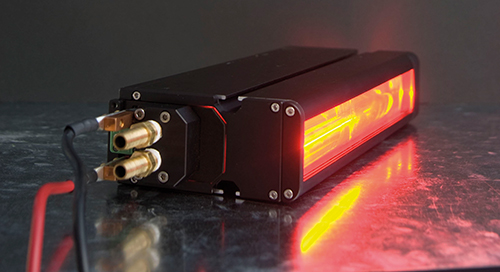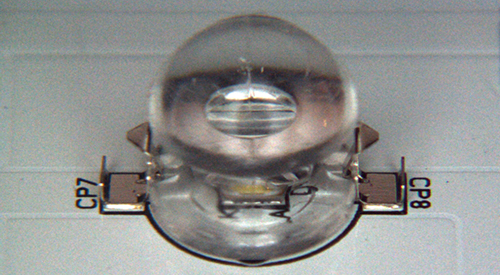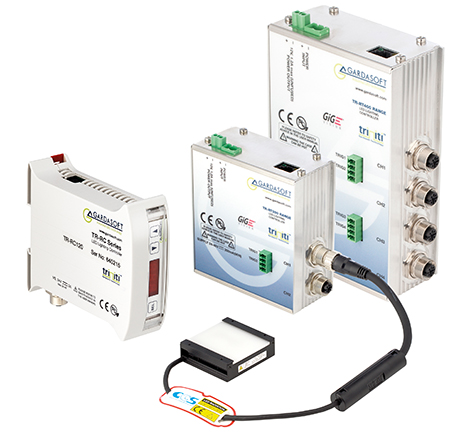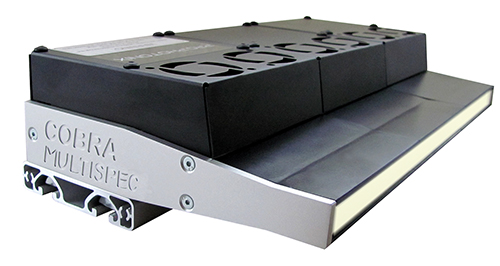Last year’s Vision Award, presented at the 2016 Vision show in Stuttgart, went to an innovation in lighting for the first time in the competition’s history. Japanese company Machine Vision Lighting won for its VISA-Method Lighting, designed to give uniform illuminance irrespective of distance from the object. The light source produces irradiation conditions that are the same at every point on the surface of an object, an effect that can’t be achieved with conventional lighting methods, or even with parallel light.
Japanese technicians and companies have been instrumental in a number of advances in lighting technology in the field of machine vision. In his earlier career working for illumination company CCS, Shigeki Masumura, the CEO of Machine Vision Lighting who accepted the Vision Award in Stuttgart, developed some of the technology that resulted in the first global lighting standard administered by the Japan Industrial Imaging Association (JIIA). The standard was revised in 2013 as JIIA LI-001-2013 and is designed so that a comparison can be made between LED and laser lighting products in terms of performance metrics, connectors and controllers.
CCS and Gardasoft, which developed its illumination technology in the UK but is now owned by Japanese lighting company Optex, have also proposed lighting-specific commands for GenICam, the communication and control backbone used within camera interface standards such as GigE Vision, USB Vision, CoaXPress, and Camera Link HS. Gardasoft is leading the working group defining a standard for GenICam registers for lighting controllers – the company offers its Triniti lighting controller. The addition to GenICam has broad agreement and is waiting for approval, according to Peter Bhagat, one of the founders of Gardasoft. This will standardise how lighting and controllers interact with each other and the rest of the vision system. As an aside, cameras can also control the light source – Sony cameras have the ability to output a strobe signal to lighting devices in a pre-scheduled timing with up to 16 lighting commands.

CCS PF series offering high light intensities with short pulse widths
Marc Landman, vice president of CCS America, commented: ‘GenICam will help standardise the communication and control of lighting, but standardised [lighting] performance measurements meaningful to machine vision applications are still lacking.’ He added that there is a need in machine vision lighting for something similar to the EMVA 1288 standard, which quantifies and compares cameras, but that there isn’t a strong effort yet within the lighting community to create such a standard.
The difficulty with specifying lighting, according to Matthias Dingjan, a product manager at CCS Europe, is that the power of a light source can be described by different metrics, lumen, lux, or irradiance at 50mm working distance, for example. It also depends on how intensity is measured: is it the output at the emitting surface, or is it via Lambertian reflection? ‘If you do not take these things into account, comparing one light to another would be like comparing apples to oranges,’ he remarked.
Creating contrast
The basis for any successful imaging application is a high quality image, and typically the quality and getting the necessary contrast in the image comes from how the object is lit – Dingjan estimated that 90 per cent of the application can be solved just by selecting the right light. ‘Unfortunately, lighting is usually the last component added to the bill of materials, when it should be the first,’ commented Matt Pinter, director of engineering for Smart Vision Lights, adding ‘the best camera and image processing software cannot extract intelligence from an under- or over-saturated image.’
Pinter advised that when engineering a new vision system integrators and end-users should start with the specifics of the application, factors like what colour light will result in the greatest contrast between the feature and its surroundings; feature size versus image area versus sensor resolution; throughput and how it relates to product tracking and exposure times; and the frame rate. ‘In all these cases, lighting has a direct impact on system performance, and customers will need advice from lighting and automation suppliers to develop the best possible machine vision solution at the most affordable price,’ he said.

The Line High Power series of line scan lights from Smart Vision Lights uses 192 high-power LEDs for every 300mm
Most lighting choices are specific to the application. Detecting the absence or presence of a part on production line could be solved in a few days using smart cameras with integrated on-axis lighting, according to Pinter, while bottle inspection might require a UV backlight, and high speed web inspection a bright LED line light. For the more sophisticated vision systems, Pinter said that a certain amount of experience is needed and knowledge of working with lighting and optics to specify the system. ‘When choosing a lighting vendor, system integrators must ensure that their supplier has an extensive lighting laboratory for testing, can supply a range of products in different configurations and wavelengths, and whether the supplier has any prior experience in solving particular problems,’ he noted.
High speed web inspection and fast line scan cameras, in particular, are driving the advances being made in line lights, which are getting longer and need more power, according to Bhagat. He said: ‘We are seeing more applications where systems use a single line scan camera and interleave two different lighting schemes on alternate lines. This saves a lot of cost without losing resolution, as long as you can drive the light with enough current and at a high enough frequency.’ Gardasoft has achieved more than 500kHz pulse rates under ideal conditions, ‘which gives the camera guys something to aim at’, Bhagat added.
Advances in LEDs
A lot of the lighting solutions for machine vision are now based on high brightness, uniform LEDs, often in the form of high density, multi-LED arrays. ‘Our customers are asking about tighter tolerances in secondary specifications often related to the performance as an array, not just the individual LED specification,’ commented Landman at CCS America. He said the most popular specifications include: the tolerance of the colour temperature for white LEDs or centre wavelength for single colour LEDs; array performance of the LEDs with thermal variations on a daily or hourly basis; long term variations in the light array uniformity and decreased output as the unit ages; and out-of-the-box unit-to-unit variations.

Smart Vision Lights uses silicone gels to encapsulate individual LED diodes
CCS has introduced active control loops in its FastUS line of products to minimise variations found in LEDs, namely ambient temperature variations, which affect the junction temperature of the LEDs, causing a corresponding shift in the intensity, and a natural phenomenon whereby the LED junction decreases its output for a given drive current as it ages, which can limit the maximum intensity of the light or cause a long-term shift in yield performance. As a result, both can significantly affect narrow pass/fail windows in vision tools based on colour or intensity.
The CCS FastUS technology uses two active feedback systems to limit these factors. First, short loops of only two or three LEDs are fed by an onboard, local constant current supply. This circuit is then repeated in mass parallel on the main PCB to make the full light array, each current loop having an independent thermal sensor. The constant current operation in short local loops of LEDs helps minimise LED-to-LED variations in the array, giving better light uniformity without the cost associated with tightly binning LEDs to match. The thermal sensors stabilise the constant current level to offset any light output variations caused by junction temperature changes in the LEDs. All of this is onboard the main PCB in the light, although a controller can still be used if strobe, dimming, or other functions are required – more advanced features are available when the FastUS light is used in conjunction with a FastUS controller.
Last year, according to Pinter at Smart Vision Lights, several breakthroughs were reported in LED design, including the development of brighter and more efficient green LEDs, the world’s first RGB LED, and ultraviolet LED curved lens technology. Semiconductor vendors are also employing automation techniques to reduce the size of the drivers, he added.
Smart Vision Lights uses silicone gels to encapsulate individual diodes to maintain an optimum operating temperature in some of its LED lighting products – its LCHP water-cooled line scan light, which uses the gels, can produce five million lux. The company also has patented an automated surface mount system for its silicone lenses to reduce costs and improve performance.
‘Developments such as RGB LEDs will allow lighting manufacturers to build products with even smaller footprints for flat continuum solid-state light sources,’ Pinter remarked. ‘The use of silicone gels will improve thermal designs and increase the lifetime of such lighting products. Novel lens designs will be used to provide system integrators with products that more effectively maximise the efficiency of their designs. As machine vision systems are highly dependent on lighting, such products will eventually emerge as peripherals that can, over networked interfaces, intelligently adapt to different machine vision applications.’
Computational imaging
While it remains true that a successful imaging application begins by capturing a high quality image, computational imaging techniques able to handle variable lighting conditions are now being used in machine vision, according to Landman.
Computational imaging uses multiple images grabbed in fast sequence and computed through an algorithm to get the output image. Common examples of this are HDR imaging using two or three images, photometric stereo (PMS) for surface details, and strobing a monochrome camera with red, green and blue flashes to assemble the three colour planes into a high-resolution colour image – ‘more possibilities exist and are coming,’ Landman said.

Gardasoft’s Triniti controller gives expert control of a vision lighting system
Cognex recently launched its SurfaceFX product, which uses PMS to capture a sequence of images in conjunction with timed lighting. ‘The launch of mainstream SurfaceFX and other products by major players has caused an increased market awareness and demand for various computational imaging techniques,’ Landman observed.
‘Because computational imaging systems extract features of interest out of several images, such as tracking how shadows are affected by edges in the case of PMS, often the lighting and image quality requirements for the application are reduced,’ he added. ‘As long as the computer algorithm can find the information it needs in one or more of the images, such as shadow information, the absolute image quality may not matter as much. This can greatly simplify requirements for uniformity, saturation, glare, etc. As a result, often the total lighting solution can be less expensive than trying to capture a single high quality visual image in a difficult lighting application, while still expanding the robustness and window of operation.’
Future advances in lighting such as more efficient dies and multispectral LEDs ‘will allow LED developers to reduce manufacturing costs and offer higher performance products,’ commented Pinter (for more on spectral illumination, see the panel ‘Spectral solutions’). In addition, big data analytics enabled by the Internet of Things (IoT) is beginning to be used in factory automation, and Landman noted that ‘better data linking the actual cause of yield failures will enable vision systems to tune the lighting or other system components to counteract these variations. You can envision that self-learning systems or systems tuned from centralised IoT management will result in the future.’
Spectral imaging – whether that’s multispectral with discrete bands of light, or hyperspectral using narrow, generally contiguous spectral bands – is a relatively new, but growing technology in industry. There are numerous LED wavelengths available from UV through to IR and, using chip-on-board technology, these devices can be placed in dense arrays resulting in greater intensity and uniformity.
There are different illumination options for spectral imaging, but Ken Reynolds, business and technology manager at ProPhotonix, noted that LED illumination using many wavelengths ‘provides better resolution and a finer resolution for improved accuracy’.
‘The light output intensity of LEDs can be controlled precisely to within microseconds ensuring the desired emission spectrum is achieved,’ he continued. ‘Using electronic software control, the light output intensity of the LEDs can be kept stable for a very long time. Importantly, this level of control is scalable for systems consisting of a couple of LEDs to a system consisting of thousands of LEDs.’
ProPhotonix has recently launched Cobra MultiSpec, a multispectral LED line light allowing users to select up to 12 different wavelengths. The electronic control allows the system to capture data on all 12 wavelengths in one strobe cycle with a total delay and response time profile of less than 1μs.

Cobra MultiSpec is a multispectral LED line light where 12 different wavelengths can be selected
Reynolds advised that integrators should first identify the wavelengths and range of wavelengths required for the application. ‘There can be significant variances in cost, performance and availability between differing LED wavelengths, so it is important to understand the level of flexibility offered by the application,’ he said.
Other lighting considerations Reynolds mentioned that integrators should be aware of when building a spectral imaging system include the level of electronic control offered by the LED array, which can determine the functionality of the system, as well as environmental aspects.
The form factor of the light also needs to be thought about, as it is important to allow not only for the space required for the light itself but to also take into account the required angle of illumination. The length of the LED line light is also important to ensure uniformity of light across the target, according to Reynolds. Typically, an LED light longer than the width of the target is necessary, which allows for a drop-off in intensity at the edges of the illuminator. ‘ProPhotonix has worked on a number of applications where this additional space was not available and has developed customised optics to overcome this scenario,’ Reynolds added.
Cobra MultiSpec is built on ProPhotonix’s Cobra Slim series, a platform that offers field adjustable optics and diffusers, allowing the user to select the optimum lens position – which determines line width and intensity – in the field.


